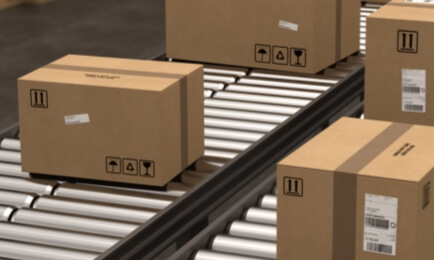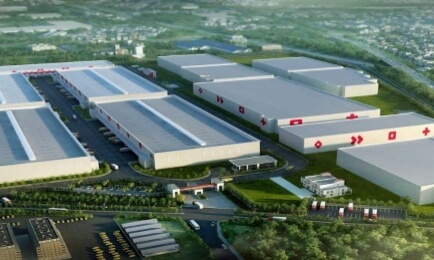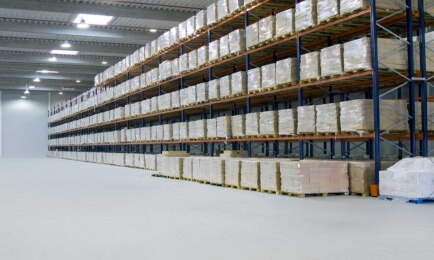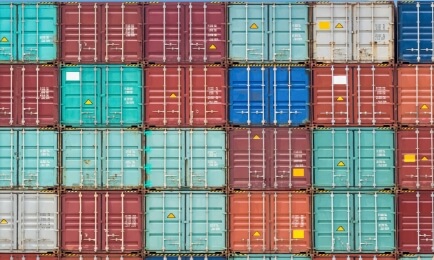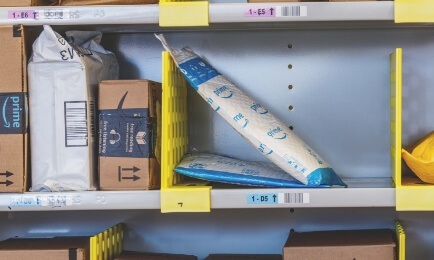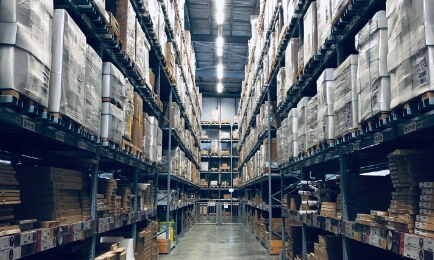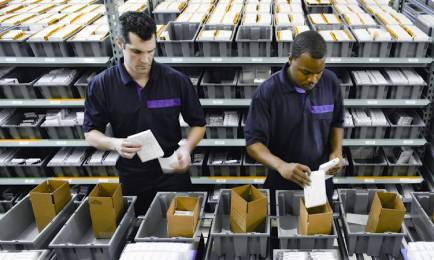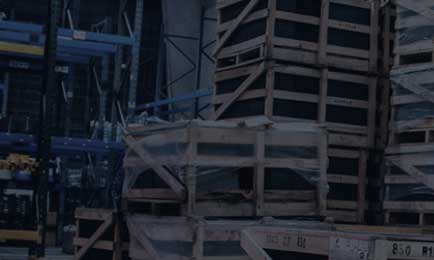For years, warehouses have played a significant role in the smooth functioning of the supply chain. Warehouses are used by manufacturers, importers, exporters, wholesalers, transport businesses, e-commerce businesses and more. Warehouses accomplish the essential function of storing goods along with services that ensure better control over inventory, from the time they are produced to the time they reach the consumer market.
Logistics comprises three primary functions that are: transportation, distribution and warehousing. Warehouses allow businesses to have maximum inventory control as they act as a centralised location that makes it easier to pick, distribute and transport goods to desired consumption centres. Warehouses also provide businesses with economic benefit, efficient storage and logistical operations help to reduce transportation costs, shipping costs, order delivery costs and more.
Warehouse storage is that vital component in the supply chain that maintains a balance between demand and supply by acting as a buffer. Warehouses are of different types, and each serves different purposes.
Types of Warehouses
General Warehouse Storage
Warehouses have evolved from basic godowns to organized spaces with state-of-the-art infrastructure. However, the modern era has an increasing demand for organized warehouses that facilitate optimal storage of inventory and assure quality and consistency to businesses. General warehouse storage provides an accumulation of goods at one place which imparts efficiency in the overall logistics system. General warehouses store inventory in various ways that range from floor storage, semi-automatic shelf racking, automatic shelf-racking, manual/robotic storage systems and more.
Bonded Warehouse Storage
By definition, bonded warehouses are "customs controlled warehouse storage for the retention of imported goods until the duty owed is paid." Bonded warehouses can be government-owned or privately owned. The primary function of bonded warehouses is to store bonded goods until customs duty is paid, or when the dutiable products are out of the warehouse. Bonded warehouses allow importers to handle temporary liquidity crunch, as no duty is paid until goods are released - giving complete control of payment to the importer. Bonded warehouse facilities also offer importers with other logistics solutions, along with various storage systems to best meet business requirements.
Fulfilment Centres
The term 'fulfilment' refers to the process of fulfilling customer orders via third-party logistics providers. Fulfilment centres are order processing warehouses that are located close to customers. With the rise of the e-commerce industry, fulfilment centres have become a vital part of the supply chain and aid activities such as order management, picking, packing, returns control and more. Although e-commerce businesses utilize fulfilment centres dominantly, they're becoming an essential component for manufacturers, retailers, wholesalers and distributors as well.
There are different storage systems incorporated at warehouses. These storage systems aim at the accessibility of inventory and efficiency of operations. At a broader level, types of storage systems are.
Types of Storage System
Pallet Racking System: is the most common storage system implemented at warehouses. Loaded pallets are stacked on racks in horizontal rows with multiple levels. Warehouses use pallet racking systems due to the austere simplicity of installation and the organisation of storage space. It is always better to install racks, as it manifests space utilisation two-folds and is cost-effective in comparison to adding a square foot of storage space at warehouses.
Stacking: is a form of floor storage at warehouses and is the process of loading one pallet over the other. Stacking can be categorized into single stacking, double stacking or block stacking. Stacking is the storage at the grassroots and doesn't require installation of any material handling equipment such as racks or shelves. Warehouses globally utilise stacking due to its low setup costs, flexibility and the ability to exploit vertical space. Proper MHE (machine handling equipment) ensures safe handling of pallets and lanes are created to assure access to different stock keeping units (SKUs).
Pallet-less Stacking: is the most traditional stacking technique that doesn't include the utilization of pallets. Rather individual cartons or boxes are stacked one over the other. Pallet-less stacking is still a prominent storage system executed at godowns. Expensive goods such as automobile engines are stored without pallets, directly on floors that ensures required access to the product and complete safety. Pallet-less stacking always remains as a natural storage system at warehouses as no investment is required.
In the past decade, warehouses have been a centralised and reliable spot for the storage of inventory, and hence, businesses have preferred opting for warehouses as long-term fixed assets. Although the current market is experiencing invariable demand, and therefore, it is difficult for companies to predict the inventory levels required to maintain at warehouses.
Inventory Overflow
Globally, businesses are dealing with seasonal peaks in demand. According to Warehouse Capacity Economics and Trends, 74% of retailers face the challenge of fluctuation in demands throughout the year. Inventory overflow is the overstocking of goods at warehouses to meet fluctuating demands successfully. At warehouses, the slow-moving SKUs results in crowded aisles and disorganized warehouse space that decreases the operational efficiency. In such situations, warehouses become victims of 'honeycombing'. Honeycombing is a bunch of slow-moving SKUs spread across the warehouse space, which makes it challenging to organize the fast-selling products.
Short-term warehousing is gaining recognition worldwide by various leading businesses and industry experts that allows brands to recruit an off-site location for slow-moving SKUs while making way for the top-selling products at the distribution centre. Corporations claim that seasonality is the most significant driver of inventory variations and supply chain disruptions. Even though long-term contracts and fixed assets make businesses feel in control of the inventory. Once the seasonality in demand surpasses; enterprises are left with spare storage space that generates no revenue.
Apart from seasonality in demand, there can be other challenges that disrupt supply chains such as trade conflicts and worldwide pandemics, the latest example of which is COVID-19. In May 2019, the trade conflict between the U.S. and China cost businesses and consumers $3 billion through higher prices. Often, small and mid-sized companies are critically affected by increasing trade conflicts as they lack the storage capacity to cope with rising inventory costs and supply disruptions. Not only in terms of money but a significant loss of time is experienced by SMBs as they also lack the funding and expertise to redirect supply routes to avoid tariffs.
On the other hand, situations like COVID-19 which led to lockdowns in nations and shut down of trade routes, transport routes and unavailability of staff members. It is often challenging to predict inventory levels during such situations and stay prepared to handle such disruptions. The e-commerce industry is experiencing a surge in demand as quarantined customers are left with no option but switch to 'panic-buying', order products online and have them delivered at their doorsteps.
Proclaimed players like Amazon and Walmart with an extensive network of distribution centres and warehouses are highly agile and prepared to have their businesses operating at times of unpredictability. It is small and mid-sized businesses that require to be responsive and antifragile. On-demand warehousing is a concept that gives complete flexibility to companies to increase or decrease inventory levels they maintain at warehouses without clinging on to long-term contracts and fixed real estate that only locks up cash. Businesses can ramp up inventory levels beforehand by storing additional stock in case of future tariffs surge, restrictions, lockdowns and delays while staying free from product shortages. The best way to solve supply chain disruptions isn't to buy or lease more capacity - it is to find the space you need to address and tackle existing short-term problems.
It's undeniable that retailers and businesses might require more storage space than they already have. A company might be dealing with seasonal demands, expansion plans into a new market, introduce new products, out-of-sync demand planning and supply chain or unpredictable trade conflicts and global issues such as COVID-19. In such cases, rushing to find additional warehouse space is not only challenging but also expensive and disruptive to business activities.
With Stockarea it is effortless to outsource overflow solutions with a nation-wide network of professionally operated warehouse spaces for pallet storage, handling and deconsolidation services for only as long as businesses need it. Stockarea is a single platform that provides operational efficiency to businesses and transparency into shipments. Stockarea's software provides true visibility into inventory, detailed analysis and billing with a single set of terms, all in one platform. Partner with us today!
Talk to an expert today 



